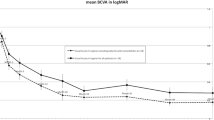Abstract
Purpose: To assess the impact of nonmechanical trephination on the graft endothelium and thickness after penetrating keratoplasty (PK). Methods: Inclusion criteria for this prospective, randomised, cross-sectional, clinical study were: (1) Treatment between October 1992 and December 1997; (2) one surgeon (G.O.H.N.); (3) primary central PK; (4) Fuchs’ dystrophy (diameter 7.5/7.6 mm) or keratoconus (diameter 8.0/8.1 mm); (5) graft oversize 0.1 mm; (6) no previous intraocular surgery; (7) 16-bite double-running diagonal suture. In 179 patients (mean age 51±18 years), PK was performed using either the 193-nm Meditec MEL60 excimer laser (”Excimer”) along metal masks with eight ”orientation teeth/notches” (53 keratoconus, 35 Fuchs’ dystrophy) or motor trephination with the Mikrokeratron (Geuder) (”Control”: 53 keratoconus, 38 Fuchs’ dystrophy). For donor trephination from the epithelial side an artificial anterior chamber was used in both groups. In 27% of the excimer and 29% of the control group a triple procedure was performed. Specular microscopy (EM-1000, Tomey) and pachymetry (SP-2000, Tomey) were performed before removal of the first suture (0.4±0.2 years postoperatively), before (1.1±0.4 years) and after (1.7±0.6 years) removal of the second suture but before any additional surgical intervention. Results: Endothelial cell count: Neither ”two-sutures-in” (1953±426/1804±385 cells/mm2, p=0.13), ”one-suture-in” (1629±439/1765±440 cells/mm2, p=0.27), nor ”all-sutures-out” (1259±493/1294±532 cells/mm2, p=0.83) differed significantly between Excimer and Control. Graft thickness: Neither ”two-sutures-in” (527±58/524±16 µm, p=0.89), ”one-suture-in” (537±72/551±40 µm, p=0.86), nor ”all-sutures-out” (576±53/565±62 µm, p=0.38) differed significantly between Excimer and Control. Cell count and corneal thickness were not significantly different comparing Fuchs’ dystrophy and keratoconus or comparing PK only and triple procedures. Graft thickness and endothelial cell count correlated highly significantly inversely with ”all sutures out” (P<0.0001). Conclusions: Excimer laser trephination from the epithelial side using an artificial anterior chamber in donors seems to have no disadvantages concerning the graft endothelium after PK. Endothelial cell loss was not increased in eyes with Fuchs’ dystrophy compared with keratoconus or after triple procedures compared with PK only.
Similar content being viewed by others
Author information
Authors and Affiliations
Additional information
Received: 7 February 2000 Revised: 7 September 2000 Accepted: 20 September 2000
Rights and permissions
About this article
Cite this article
Seitz, B., Langenbucher, A., Nguyen, N. et al. Graft endothelium and thickness after penetrating keratoplasty, comparing mechanical and excimer laser trephination: a prospective randomised study. Graefe's Arch Clin Exp Ophthalmol 239, 12–17 (2001). https://doi.org/10.1007/s004170000225
Issue Date:
DOI: https://doi.org/10.1007/s004170000225



